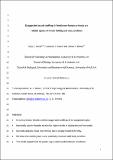Exaggerated sexual swellings in female nonhuman primates are reliable signals of female fertility and body condition
Abstract
In some species of Old World monkeys and apes, females exhibit exaggerated swellings of the anogenital region that vary in size across the ovarian cycle. Exaggerated swellings are typically largest around the time of ovulation, and swelling size has been reported to correlate positively with female quality, supporting the hypothesis that exaggerated swellings are honest signals of both female fecundity and quality. However, the relationship between swelling size and timing of ovulation is weak in some studies, and the relationship between swelling size and female quality has also not been consistently reported. Here, we collated empirical studies that have reported either i) swelling size and estimated timing of ovulation (N=26), or ii) swelling size and measures of individual quality (N=7), to assess the strength of these relationships using meta-analytic methods. Our analyses confirmed that the period of maximal swelling size is closely associated with the most fertile period of the ovarian cycle and that a large proportion of ovulations occur during the maximal swelling period. A small, positive effect size was also found for the relationship between swelling size and body condition. In contrast, the relationships with age and social rank were not significant. Swelling size, therefore, potentially signals both female condition and timing of the fertile phase. Males are likely to benefit from allocating mating effort according to swelling size, while females with large swellings potentially benefit from exerting control over matings in species where female control is compromised by male mating strategies.
Citation
Street , S E , Cross , C P & Brown , G R 2016 , ' Exaggerated sexual swellings in female nonhuman primates are reliable signals of female fertility and body condition ' , Animal Behaviour , vol. 112 , pp. 203–212 . https://doi.org/10.1016/j.anbehav.2015.11.023
Publication
Animal Behaviour
Status
Peer reviewed
ISSN
0003-3472Type
Journal article
Description
Funding was partly provided by an ERC Advanced Grant (EVOCULTURE, ref: 232823, to Kevin Laland) and by the School of Psychology & Neuroscience, University of St Andrews.Collections
Items in the St Andrews Research Repository are protected by copyright, with all rights reserved, unless otherwise indicated.

